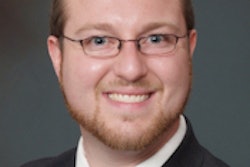SAN FRANCISCO - Use of screening mammography among women ages 40 to 49 dropped 5% in private health plans after the U.S. Preventive Services Task Force (USPSTF) changed its guidelines in 2009, according to a study presented on September 13 at the American Society of Clinical Oncology's (ASCO) Breast Cancer Symposium (BCS).
The study was among a number of presentations on breast imaging made at this week's meeting, which runs from September 13 to 15. Additional presentations on the first day of the symposium touched on barriers to screening compliance in rural areas, as well as the accuracy of risk models in predicting cancer rates.
In the USPSTF study, Dr. Amy Wang of the Mayo Clinic in Rochester, MN, and colleagues conducted an analysis using administrative claims data from more than 100 health plans. The study included women between the ages of 40 and 64 with at least one month of enrollment in their plan from January 2006 to December 2010. The group excluded Medicare claims, which meant that data from women ages 65 or older were not captured in the study; records from 7.9 million women were included, Wang and colleagues wrote.
"The November 2009 USPSTF breast cancer screening update recommended against routine screening mammography for women age 40 to 49, created confusion, and prompted organizations to release opposing statements," Wang's group wrote. "We aimed to determine if [this update] impacted screening mammography utilization."
Before the 2009 policy change, the baseline monthly mammography rate stood at 41 mammograms per 1,000 women for the 40-to-49 group and 47 mammograms per 1,000 women for the 50-to-64 group, according to the researchers. After the recommendation, the mammography rate in women ages 40 to 49 had dropped 5.72% three months after the guideline change, and 4.97% 10 months later.
The decrease in mammography screening rates translated to 53,969 fewer mammograms performed in the year following the update for women ages 40 to 49 in this dataset, Wang and colleagues wrote. Mammography rates in the 50-to-64 group were not affected.
The researchers said they were surprised that the USPSTF controversy changed mammography screening rates, according to second author Dr. Jiaquan Fan.
"We were surprised that the recommendations caused a dip at all, given that they were relatively controversial," Fan told AuntMinnie.com. "[One wonders] how doctors communicated the change in recommendation to their patients, and how patients used that information."
Barriers to screening
Despite provision of free services, concerns about cost, fear of procedural pain, and fear of abnormal results remain barriers to compliance with screening mammography among medically underserved women, researchers from Washington University in St. Louis reported in another study.
Dr. Oluwadamilola Fayanju and colleagues used data gathered from an outreach registry developed in 2006 by the university's Breast Health Center to evaluate the effectiveness of mobile mammography among medically underserved women. The registry collects medical record and demographic data as well as patients' perceptions of breast cancer screening. Between April 2006 and May 2011, 9,082 women were registered.
Most of the registrants in the program were black (54%), uninsured (74%), screened in a van (83%), lived in the greater St. Louis region (84%), had an annual income of less than $20,000 (87%), and reported a good or excellent experience as part of the outreach program (92%).
Fear of mammography's cost was the most cited barrier to getting a screening exam, listed by 40% of respondents. Other issues included pain associated with the exam (13%) and fear of bad news (13%).
The analysis also found that those who were employed and who lived in the southeastern area of Missouri had a higher likelihood of perceiving cost as a barrier to mammography, while those who had insurance and were Hispanic (compared to non-Hispanic whites) were less likely to report cost as a barrier.
Women who were screened in a van, had insurance, and were non-Hispanic black were more likely to report fear of procedural pain as a barrier. Factors such as having insurance, being non-Hispanic black, and being Hispanic were associated with reporting fear of receiving bad news as a barrier, while older women and women who were screened in the van were less likely to report this concern, Fayanju's team found.
"Barriers to screening don't necessarily correlate with obvious factors," Fayanju told AuntMinnie.com. "What we really need is to have a more nuanced educational program."
In another study, researchers from Kentucky reported to ASCO BCS attendees that women in a rural, southeastern part of that state have disturbingly low rates of screening mammography compliance.
Lead researcher Dr. Raymond Elsoueidi of Appalachian Regional Healthcare in Hazard, KY, and colleagues found that despite the dramatic improvement in the use of screening mammography in the U.S., disparities remain in southeastern Kentucky.
Elsoueidi's group collected data from Kentucky's behavioral risk factor surveillance system from 2000 through 2008, including women ages 50 and older who did not have a screening mammography within the past two years. They found significant discrepancies between the state as a whole and its southeastern area.
Overall rates of screening mammography in Kentucky
|
"I was expecting to find low screening rates, but it was quite surprising and concerning that over this many years -- eight to 10 years -- there was no improvement in screening rates in this area," Elsoueidi told AuntMinnie.com. "We need to keep trying to determine what's preventing these women from getting screening mammography, to understand the factors that contribute to low rates, and to develop effective interventions."
How good is Gail?
Finally, researchers from the Center for the Southern Interior of the British Columbia Cancer Agency in Kelowna found that the Gail model -- a breast cancer risk assessment tool -- was not sensitive among participants in the Screening Mammography Program of British Columbia (SMPBC) who were at low or high risk of the disease.
A group led by Rasika Rajapakshe, PhD, used information from 223,349 women in British Columbia who participated in the SMPBC during 2000, along with their tumor status from 2000 to 2004. The group developed a software program that calculated the absolute five-year Gail score from questionnaire data.
Overall, Gail score didn't match up well with cancer detection rates among women who were included in the study, according to Rajapakshe's team. The model significantly underpredicted cancer detection for women in Gail risk categories up to 2% and overpredicted cancer detection for women in Gail risk categories greater than 4%.
But in a related study, Rajapakshe and colleagues did relate some good news: The province of British Columbia has consistently had the lowest rates of breast-cancer-related mortality in Canada, which may be in part because of the long-term stability of the SMPBC, which was founded in 1988.
Over the past 15 years, the total number of exams provided by SMPBC per year has almost doubled, from 166,746 in 1996 to 303,157 in 2010, an increase in line with the overall aging growth of the BC population, according to Rajapakshe's group. The rate of participation in the program for rural women increased between 1999 and 2009, while the overall participation rate over that same time period remained stable (range, 48% to 51%). The cancer detection rate also remained stable, the team found, in a range of 3.4 to 4.5 cases detected per 1,000 screens.




















